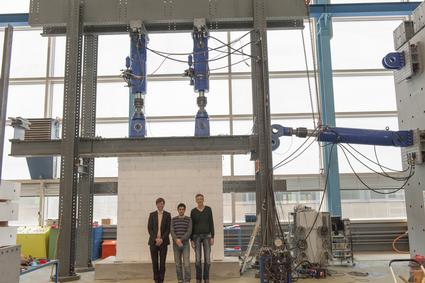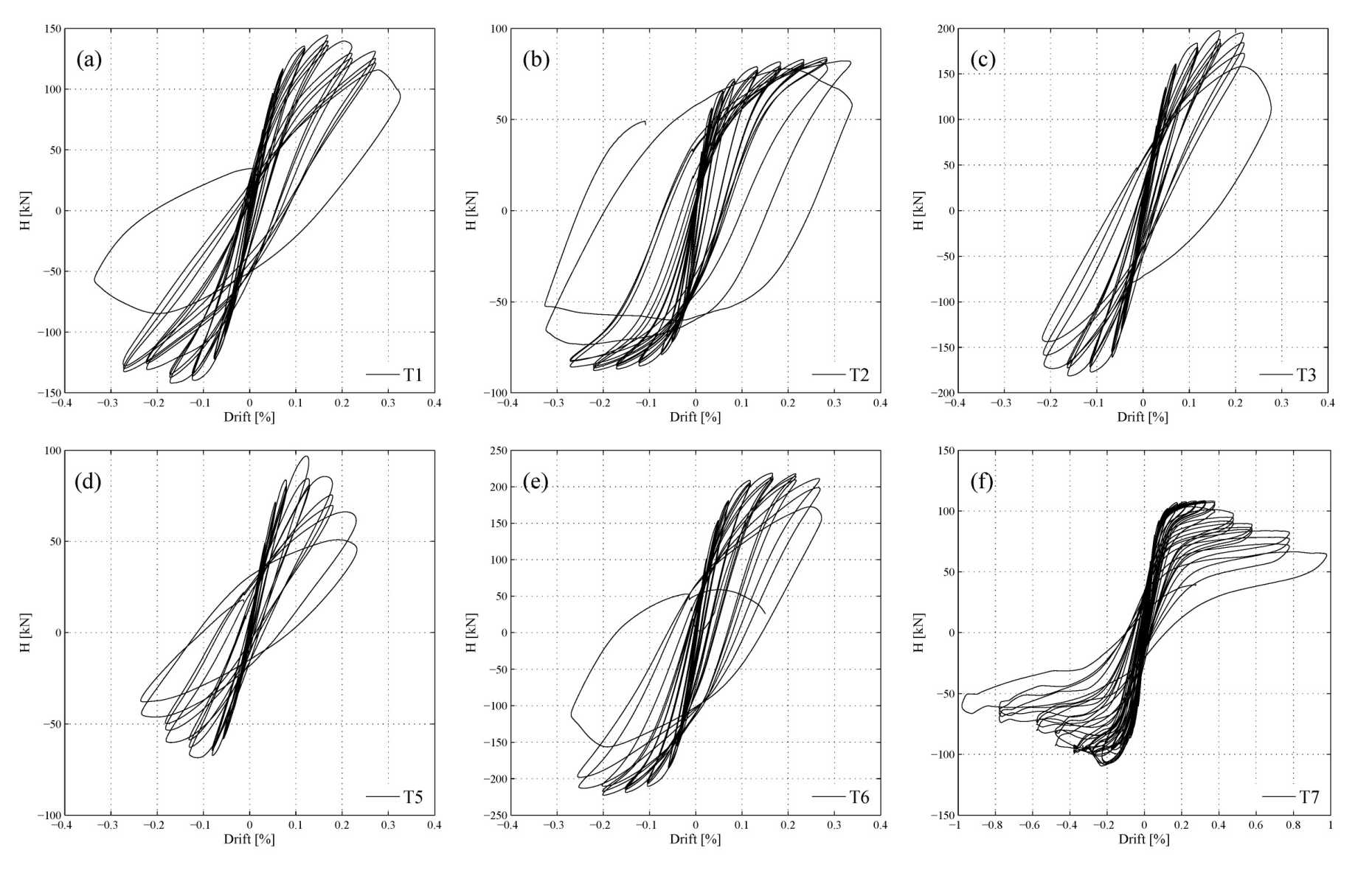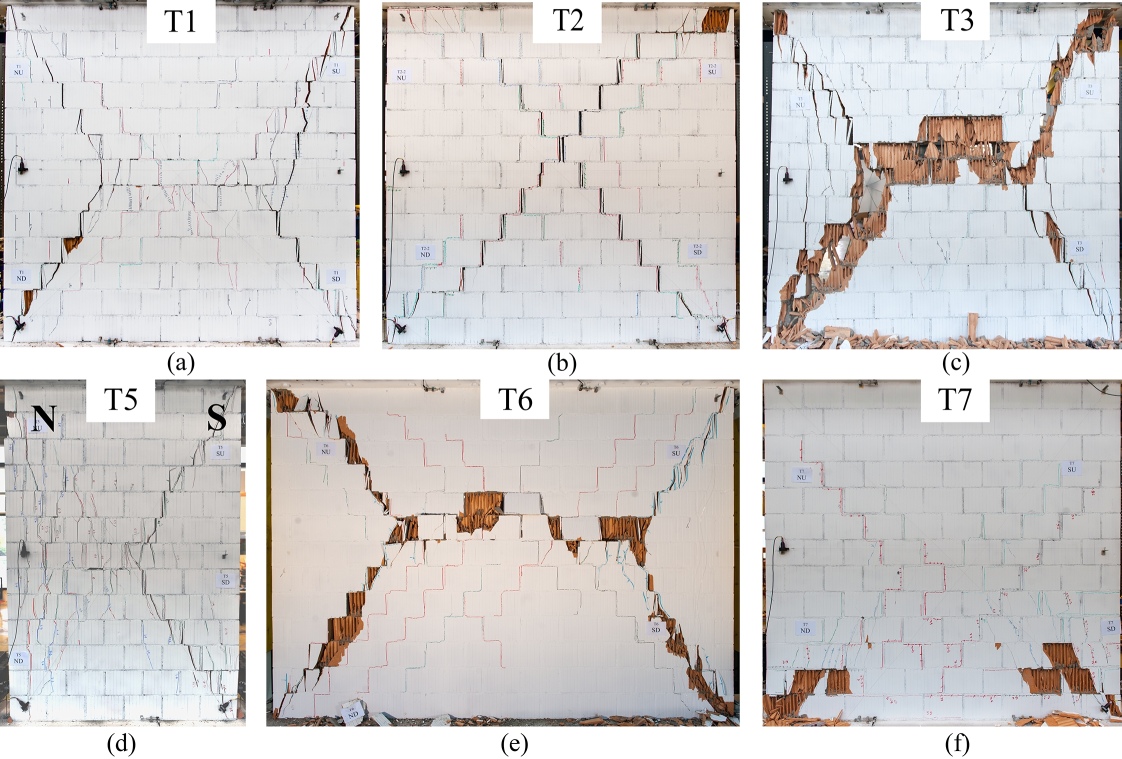Deformation Capacity of Structural Masonry
The development of the basic building stones for the deformation-based design of masonry structures is the objective of the present research project, which should be seen as a first step in an initiative to investigate the limits of the deformation capacity of structural masonry. The research project will include a thorough survey and assessment of existing theoretical and experimental research in the area of deformation capacity of structural masonry, both internationally and nationally, identification of governing parameters for own experimental work as well as developing and introducing new, sophisticated mechanical models for structural masonry. A novel approach will be developed and utilized for the purpose of applying experimental evidence collected from own tests performed on large-scale masonry structural elements for the development of reliable mechanical models.
The research project is funded by external pageSwiss National Science Foundationcall_made (SNF) and will be conducted together with Prof. Dr. Joseph Schwartz from Institute for Technology in Architecture. Project is also supported by external pagepromurcall_made, Swiss industry partner for masonry, Bern.
As the initial phase of the research project, a review of the technical literature on experimental and analytical research on the deformation capacity of structural masonry was conducted. Regarding the experimental research, the review was focused on the shear tests carried out on full-scale unreinforced, unconfined masonry shear walls made of clay bricks and bed joints filled with general purpose mortar because this combination covers most of the masonry construction in Switzerland. A considerable number of tests were reviewed and a summary of 71 tests that provided useful information in regard to the deformation capacity were presented in the form of a database. In addition to experimental research, a substantial amount of theoretical work has been invested in modelling structural masonry. In general, three different approaches are found in the literature for modelling the seismic response of URM structures, as previously mentioned: micro-modelling, macro-modelling and macro-element discretization.
In conclusion, the literature survey shows that our current state of knowledge about the deformation capacity of structural masonry is limited. The available experimental data is too scattered, and it is not possible to identify a rational value for the deformation capacity of masonry structures based only on such experimental data. Furthermore, there are no reliable and practical analytical models for the force-deformation relationship of structural masonry: refined finite element models, besides being too complex for everyday engineering practice, suffer from numerical instabilities in the post-peak regime, and available structural macro-elements are still very far from being considered accurate enough regarding the deformation capacity parameter, especially in case of the diagonal shear failure mode.
This review is presented in following publications:
- A. Salmanpour, N. Mojsilovic and J. Schwartz: "Deformation Capacity of Structural Masonry: A Review of Experimental Research", Proceedings, 15th International Brick/Block Masonry Conference, Florianopolis, June 3-6, 2012, CD-ROM, Paper No. 4C2.
- A. Salmanpour, N. Mojsilovic and J. Schwartz: "Deformation Capacity of Structural Masonry: A Review of Theoretical Research", Proceedings, 15th World Conference on Earthquake Engineering, Lisbon, September 24-28, 2012, Paper No. WCEE2012-2145.
- A. Salmanpour, N. Mojsilovic and J. Schwartz: "external pageDeformation capacity of unreinforced masonry walls subjected to in-plane loading: a state-of-the-art reviewcall_made", Journal of Advanced Structural Engineering, 5:22, 2013, SpringerOpen.
In order to investigate the deformation capacity of structural masonry, a comprehensive test program will be performed in two phases, i.e. preliminary and main phases, and will consists of a total of 11 cyclic quasi-static tests on full-scale unreinforced masonry walls made of clay and calcium-silicate blocks. The goal of the testing is to investigate the effects of the various factors, i.e. unit type, vertical pre-compression level, aspect ratio, size effect and boundary conditions on the deformation capacity of unreinforced structural masonry.
In the preliminary phase of the experimental program a total of four tests, P1 to P4, were carried out on the walls made of clay (P1 and P2) and calcium-silicate (P3 and P4) units with general purpose mortar in the bed and head joints. The specimens were tested with fixed-end boundary conditions at two different levels of pre-compression, i.e. 10% (P1 and P3) and 15% (P2 and P4) of the mean masonry compressive strength perpendicular to the bed joints.

The test set-up is shown in the figure above. The specimens are built on 350 mm thick reinforced concrete foundations which can be clamped to the strong floor by means of post-tensioned steel bars. The horizontal servo-hydraulic actuator reacting on the strong wall of the laboratory applies a shear force to the top of the walls through a stiff steel beam (loading beam). The loading beam is connected to the walls by a layer of mortar. The vertical load is applied by means of two servo-hydraulic actuators reacting on the reaction frame. A 2D Digital Image Correlation (DIC) measurement system was used to capture the deformation of the specimen. Clicking on the photos (below) of the specimens P2 and P4 two videos showing the deformation during the tests can be viewed.
Due to the formation of a sliding mode in the calcium-silicate walls (P3 and P4), they were able to exhibit a higher deformation and energy dissipation capacity compared to the clay walls (P1 and P2). However, in both cases, the obtained (average) values of the ultimate drift capacity of 0.35% and 0.38% for clay and calcium-silicate walls, respectively, were somewhat below the value given by Annex 3 of EN 1998-3 for the ultimate drift capacity of unreinforced masonry walls failing in shear. Furthermore, as expected the deformation capacity of the walls decreased as the vertical pre-compression load increased. Figures above and below show hystreses and failure of the walls P2 and P4, respectively.
The results of the first phase (preliminary tests) of the experimental work are presented in:
A. Salmanpour, N. Mojsilovic and J. Schwartz: "DownloadExperimental Study of the Deformation Capacity of Structural Masonry (PDF, 744 KB)vertical_align_bottom", Proceedings, 12th Canadian Masonry Symposium, Vancouver, British Columbia, June 2-5, 2013, Paper No. 161.
In the second phase of experimental work, six tests on large, full-scale clay block masonry walls were conducted. All the specimens (regardless of their failure mode) exhibited limited displacement capacity (see the hystereses curves below).
The test results showed that as the vertical pre-compression level increases, the displacement capacity decreases. Furthermore, they indicated a possible reduction in the displacement capacity of URM walls in the case of an increase in height or a decrease in aspect ratio. A proportional relation was also found between the displacement capacity and the shear span, which is controlled by the boundary conditions. It was also shown by the results that the current codes of practice overestimate the effective stiffness and the displacement capacity of contemporary URM walls, so they could result in an unsafe design.
A 2D Digital Image Correlation (DIC) measurement system was used to capture the deformation of the specimen. The developement of the displacement and strain fields of the specimen T6 can be viewed in the video below.
The results of the second phase of the experimental work are presented and discussed in detail in the following publications:
- A. Salmanpour: "external pageDisplacement capacity of structural masonrycall_made", PhD thesis, ETH Zurich, 2017.
- Mojsilović N. and Salmanpour A.H.: "external pageMasonry walls subjected to in-plane cyclic loading: Application of Digital Image Correlation for deformation field measurementcall_made", International Journal of Masonry Research and Innovation, Vol. 1, No. 2, 2016, pp. 165-187.
- A. Salmanpour, N. Mojsilovic and J. Schwartz: "external pageDisplacement capacity of contemporary unreinforced masonry walls: An experimental studycall_made", Engineering Structures, 89, 2015, pp. 1-16.
- A. Salmanpour and N. Mojsilovic: "Simulation of Boundary Conditions for Testing of Masonry Shear Walls", Proceedings, International Conference of Computational Methods in Sciences and Engineering, Athens, Greece, March 21-23, 2015.
- N. Mojsilović: "Assessment of the Unreinforced Masonry Shear Wall Stiffness", Proceedings, International Conference on Construction Materials and Structures, Johannesburg, South Africa, November 24-26, 2014. pp. 1157-1163.
- A. Salmanpour, N. Mojsilovic and J. Schwartz: "Effects of Pre-compression Level on the Deformation Capacity of Unreinforced Masonry Walls", Proceedings, 10th PhD International Symposium in Civil Engineering, Quebec, Canada, July 21-23, 2014, pp. 455-460.
- A. Salmanpour and N. Mojsilovic: "Application of Digital Image Correlation for strain measurements of large masonry walls", Proceedings, 5th Asia Pacific Congress On Computational Mechanics, Singapore, December 11-14, 2013, Paper No. 1128.
This project has been completed.


